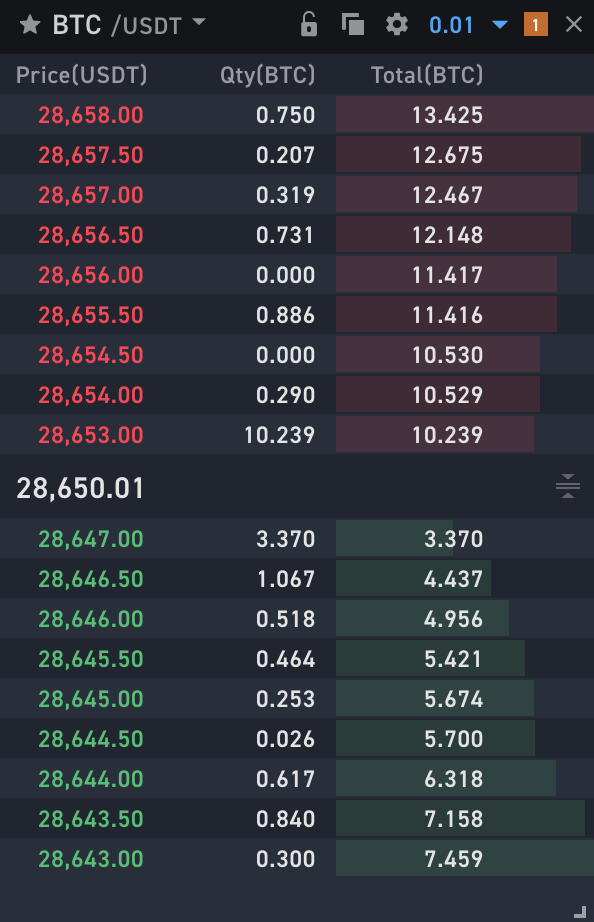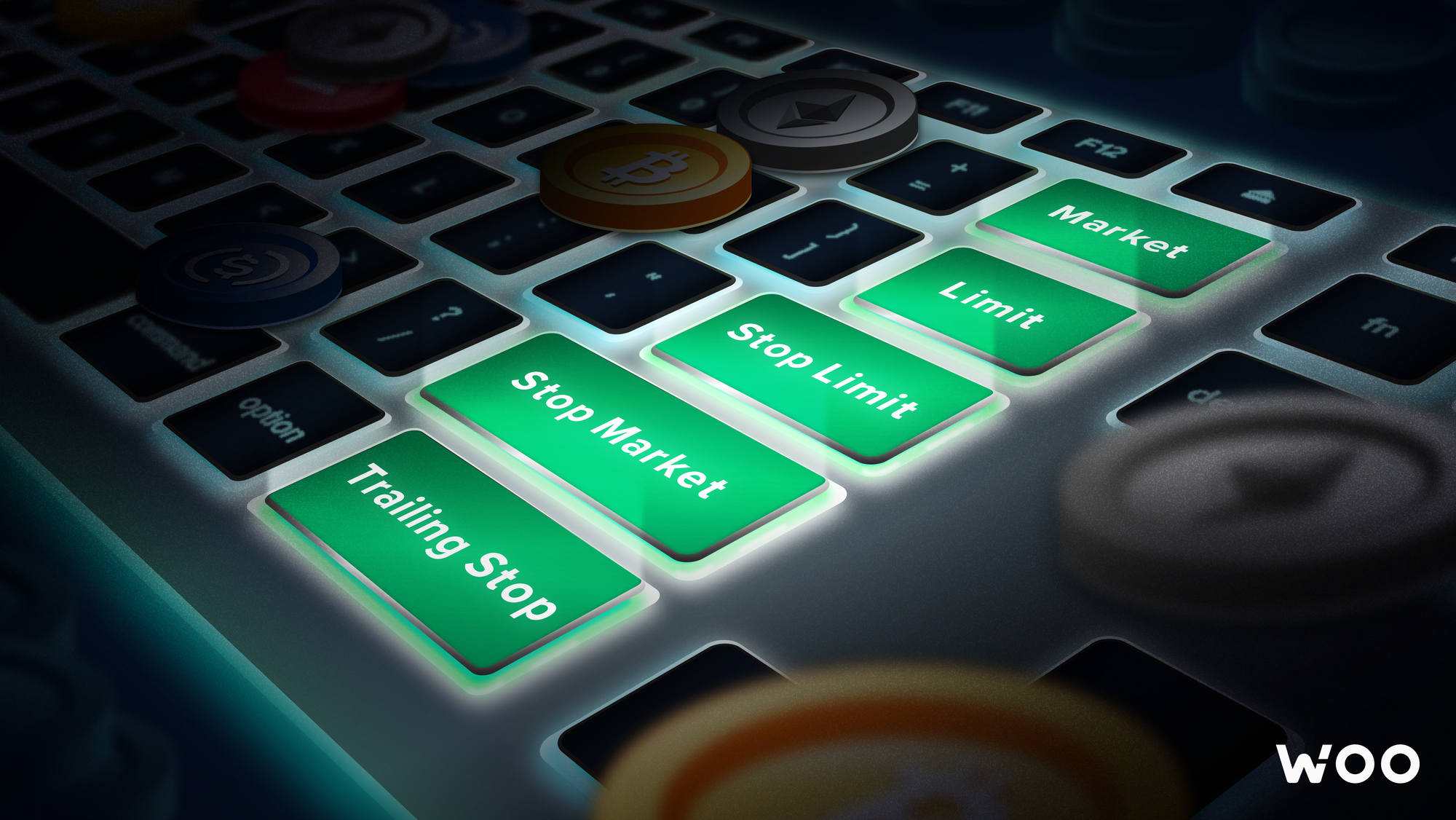Crypto exchanges allow us to buy and sell our cryptocurrencies - be that with or without leverage. These transactions are executed after certain orders enter the system, containing all the details about the desired transaction. In today's article, CryptoJelleNL dives into the order types available on WOO X, and what they mean.
An order is an instruction of sorts, where you tell the crypto exchange what you want to do, be that buying or selling a specified amount of tokens. Depending on the order type, you can be more specific, such as by providing instructions on the price at which you want your order to fill or execute. All in all, order types allow you to trade crypto in a myriad of ways. Let's discuss how it works!
Order types on WOO X
Different exchanges work in different ways, and WOO X is no exception. When trading on WOO X, you will be able to send different orders into the orderbook, using the following order types:
- Limit Order
- Market Order
- Stop Limit Order
- Stop Market Order
- Trailing Stop Order
- OCO Order
What is an orderbook?
Before we can discuss those different order types - it is important to discuss what orderbooks are: a central database that stores all buy and sell orders for a specific asset and displays them in a simple manner. The orderbook is meant to give insight into the available liquidity and demand, by showing the order price, and size.

When traders place orders, they are sent to the orderbook, where a matchmaking engine brings supply and demand together, finding buy orders willing to buy the tokens that were put on the market with a sell order. As you can probably imagine, the orderbook updates rapidly as new orders are sent and executed.
What is a Market Order?
Market orders are the simplest order type to understand, they allow you to buy or sell a cryptocurrency instantly, at the best available price. This is used by traders who want to get into the market as soon as possible, accepting a potentially suboptimal entry in the process. For example, when Dave wishes to buy one Ethereum as quickly as possible, and does not care to pay an extra dollar or two in the process.
The market order has advantages and disadvantages. What a market order gains in speed of execution, it often loses in costs. Because market orders are executed at the best available prices, it is considered a taker order (for it takes away liquidity from the order book), for which a higher fee is usually charged. WOO X stands apart from the crowd there, as staking just 1800 WOO tokens will allow you to send endless market orders into the books, without paying any fees.
Nevertheless, even on WOO X, there is an extra cost associated with market orders. As discussed, these orders are executed at the best available price. In most cases, that price is extremely close to the market price, but when books are thin, a big market order may get executed at a higher price than ideal. This is called slippage.
For this reason, traders with sizable accounts often prefer to use limit orders.
What is a Limit Order?
Limit orders are the order types traders use to eliminate slippage. While market orders are filled at the best available price, a limit order allows you to specify at which price you want to do business. For example, if you set a Limit Buy Order for Bitcoin at $28,000, it will only execute at $28,000 (or lower).
The name for Limit order makes perfect sense, seeing as it allows you to put a limit to the price you are willing to pay or accept for an asset - eliminating unnecessary slippage. With the additional control over execution price, limit orders also allow traders to place bid orders lower or higher than current prices, in preparation for a pump or dump.
A drawback of limit orders is that they are never guaranteed to fill - which is why some traders opt for market orders instead - market orders that are often filled by resting limit orders, which stay in the orderbook until another order matches it.
What are Stop Orders?
Stop orders are known by traders as a safeguard - protecting against financial ruin. But how do they work? A stop order is an order type that only enters the orderbook after a specific price level (the stop) is reached. Traders specify this price level in advance, and when the market touches the stop, it sends the order into the orderbook.
These stop orders come in different forms; Stop Limit, Stop Market, and Trailing Stop orders.
What is a Stop Market Order?
Again, the stop market order is the simplest of the three, so let's start there. After the stop level is triggered, a market order is sent into the books, executing a buy or sell order at the best available price.
What is a Stop Limit Order?
A stop limit order adds control over the price at which it is filled, so after the stop level is triggered, a limit order is sent into the books, executing only if price also reaches the price level specified in the limit order. A stop limit order therefore may not be filled, which is why the majority of traders use stop-market orders.
What is a Trailing Stop Order?
A trailing stop order is a stop market order that follows the price development by a fixed amount. For example, when adding a trailing stop order to a bullish (long) trade, the trailing stop will move upwards with the market, but stay fixed in place when the market goes down. In this way, the stop order will protect profits for extended periods, without having to pay much attention.
Example: Mark enters a Bitcoin long at $17,000, with a Trailing Stop $500 lower. When the market moves towards $21,000, his stop loss is still $500 below the market, this time at $20,500. This process continues until price retraces more than $500 from a peak - as this is where it will go below the stop level.
What is an OCO Order?
OCO Orders allow traders to completely set and forget about a trade. This combination of two instructions is built so that the execution of one, cancels the other. For example, when you place a limit sell order at $40,000, and a stop market order at $23,999 - the stop loss is canceled if the limit sell is filled, and oppositely if the stop market order is triggered.
Closing thoughts
That concludes our writeup on the different order types on WOO X. Different trading strategies call for different order types, and perhaps this article helps you understand the possibilities of less commonly used types, such as the Trailing Stop, or OCO order.
Other exchanges may have different definitions or names for order types, which makes it important to consult their own documentation before using the exchanges.
Writer’s Disclaimer: This article is based on my limited knowledge and experience. It has been written for educational purposes. It should not be construed as advice in any shape or form. Please do your own research.
Editor's note: CryptoJelleNL provides insights into the cryptocurrency industry. He has been actively participating in financial markets for over 5 years, primarily focusing on long-term investments in both the stock market and crypto. While he watches the returns of those investments roll in, he writes articles for multiple platforms. From now on, he will be contributing his insights for Alpha Circle as well.
Check out his twitter: twitter.com/cryptojellenl
—
The content above is neither a recommendation for investment and trading strategies nor does it constitute an investment offer, solicitation, or recommendation of any product or service. The content is for informational sharing purposes only. Anyone who makes or changes the investment decision based on the content shall undertake the result or loss by himself/herself.
The content of this document has been translated into different languages and shared throughout different platforms. In case of any discrepancy or inconsistency between different posts caused by mistranslations, the English version on our official website shall prevail



